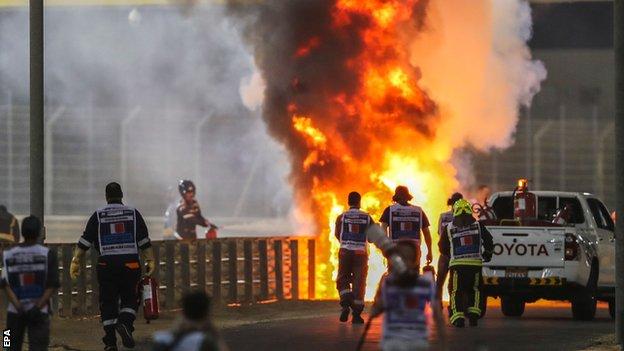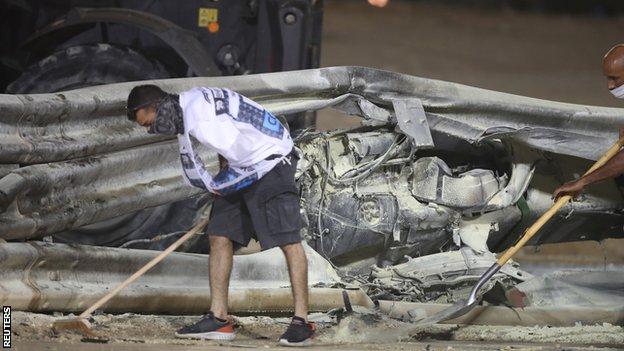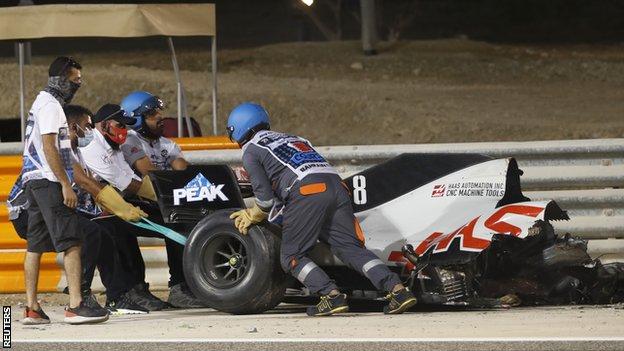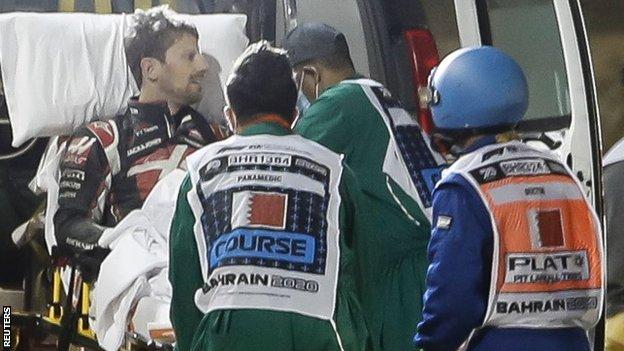Romain Grosjean somehow escaped from the most horrifying Formula 1 accident in six years with burns to the back of his hands – and the sport is still reeling from the shock of the incident and the amazement that it was not so much worse.
The crash had the appearance of something from a bygone age, as the car broke in two, caught fire and split the barrier, before coming to rest embedded between two twisted sheets of metal on its side.

How Crash Happened?
Grosjean hit the barrier at 137mph and the impact measured a force of 53G. He was in the inferno for nearly 30 seconds before extracting himself and then being helped over the barrier by FIA doctor Ian Roberts, who had just arrived in the medical car, run towards the flames, and helped a marshal set off a fire extinguisher before going to the driver’s aid.
The last time an F1 car split in two was at Monaco in 1991. The last time one caught fire in a crash was at Imola in 1989. And you have to go back to the 1970s to find accidents in which cars pierced barriers in such a way. On both occasions, at Watkins Glen in the USA in 1973 and 1974, the drivers, Francois Cevert and Helmut Koinigg, were killed.
There were a series of extremely concerning aspects to the accident, but perhaps the most striking lesson was the effectiveness of the steps F1 has made in recent years on safety.

In particular, it seems certain the halo head-protection device, introduced amid significant controversy in 2018, saved Grosjean’s life. The wishbone-shaped titanium structure that wraps around the driver’s head from the front of the cockpit looks to have taken the impact of the metal barriers.
“It was such a shocking image to see,” world champion Lewis Hamilton said after winning the race. “His car, the cockpit, I don’t know what Gs he pulled, but I’m just so grateful that the halo worked. I’m grateful the barrier didn’t slice his head off. It could have been so much worse.”
The Halo Saved Romain’s Life
After the death of Ayrton Senna in 1994, F1 started a safety crusade that has never let up since. A number of improvements introduced as a result helped Grosjean – stronger cars with better crash absorption, better helmets, the Hans neck-protection device, improved fireproof overalls and so on – but perhaps the halo is the single biggest one.
The FIA was already working on a cockpit head-protection device when Frenchman Jules Bianchi suffered fatal head injuries when he hit a recovery vehicle during the 2014 Japanese Grand Prix.
But when the late FIA F1 director Charlie Whiting was trying to push through the halo, with support from the Grand Prix Drivers’ Association chairman Alexander Wurz, many opposed it, including then-F1 boss Bernie Ecclestone.
They said it was against the spirit of the sport, that it undermined the DNA of F1 as an open-cockpit formula, that it was ugly; even that it was not necessary.
Hamilton was initially of this view, too, until he had his mind changed by a presentation given by Whiting at the 2016 Hungarian Grand Prix which demonstrated what the halo could do.
This pressure even led to a year’s delay in the halo’s introduction, but when it was finally fitted to the cars in 2018, it quickly proved its worth.
At the Belgian Grand Prix that year, Fernando Alonso’s McLaren was launched into the air at the start and flew over Charles Leclerc’s Sauber, hitting the halo on its way. That ensured any remaining noise about the halo died down, and Grosjean’s accident has ended the debate for ever.
Even with the halo, the pictures of the remains of Grosjean’s car embedded in the barrier leave you open-mouthed with wonder at how he survived.
And a series of F1 figures, from Hamilton and Red Bull driver Max Verstappen, through team bosses Toto Wolff and Christian Horner – both of whom were originally opposed to it – to F1 managing director Ross Brawn agreed the halo had saved his life.
“There is absolutely no doubt the halo was the factor that saved the day – and saved Romain,” Brawn said.
Grosjean, too. In a video message from his hospital bed on Sunday night, he said: “I wasn’t for the halo some years ago, but I think it’s the greatest thing that we brought to Formula 1 and without it I wouldn’t be able to speak to you today.”
Whiting died at the Australian Grand Prix at the start of the 2019 season, and is still greatly missed. He was not the sole person behind the halo – it involved a lot of work by a lot of people at the FIA and teams such as Mercedes and Ferrari. But this will be his greatest legacy.
Other Important Concerns
On one level, then, this was a very positive day for F1.
As Horner put it: “The car has gone through the barrier. He has survived that impact. The car, the safety cell, the halo, the fireproof overalls, the belts, the Hans system, the extraction, the FIA crew being there within seconds, the guys fearlessly going in to extract him from the car. Of course you’re always going to learn but I would say that’s the biggest result of the day.”

There remain worrying aspects to the accident.
Firstly, the barrier itself, and how the car managed to penetrate it.
“The angle must have been so precise,” Wolff said, “like a knife going through the barrier. I didn’t think modern barriers could split like this, and we need to analyse how this could happen.”
Was this a failure of the barrier? Was it a function of the design of the front of an F1 car if it hit a barrier in such a way that was previously unknown?
Secondly, what happened to create the fire? The conflagration, though large, does not seem to have been big enough for it to have been the entire 100kg fuel load in the car.
So was it a broken fuel line? Was it a compression of the tank forcing a relatively small amount of fuel out of the filler?
And wrapped up in the issue of the fire is why the car came apart in the way it did. As Wolff said: “The car breaking shouldn’t happen – the rear should break off with the engine and not the engine staying on the chassis.”
And most concerning of all, were the safety facilities as good as they could have been? Grosjean managed to get himself out of the car, but still he was engulfed in a fire for nearly half a minute.
What would have happened if he was unconscious? How quickly would the fire have been put out and would the marshals and medical crew, who were wearing open-face helmets, have been able to get him out in time?
“We have got to do a very deep analysis of all the events that occurred,” Brawn said, “because there are a number of things that shouldn’t have happened.”
The Risk In Motorsports

Most of all, Grosjean’s accident was a reminder of an inescapable truth about F1 – and all motorsport. It is dangerous, and always will be, and the drivers are putting their lives on the line every time they go out on track.
“It is what makes the sport,” Wolff said. “The best drivers, gladiators, in the most sophisticated machines. But for everyone who saw the pictures it was difficult. When we saw Romain getting out of the car what looked relatively unhurt, that was a big relief. Still being burned – second-degree burns – is bad enough. But it could have been terribly worse.”
“We got lucky,” Haas team boss Gunther Steiner said. “An angel was with us.”
“It really hits home,” said Hamilton. “We want safety for everyone and worry for everyone when there is a crash.
“I am really grateful he is safe and was able to get out but it is a real stark reminder of how dangerous this sport is, the speeds we do, and the energy we are carrying.
“The FIA have done an amazing job, but we can’t stop where we are. We’ve got to keep on trying to improve.”






Leave a Reply
You must be logged in to post a comment.